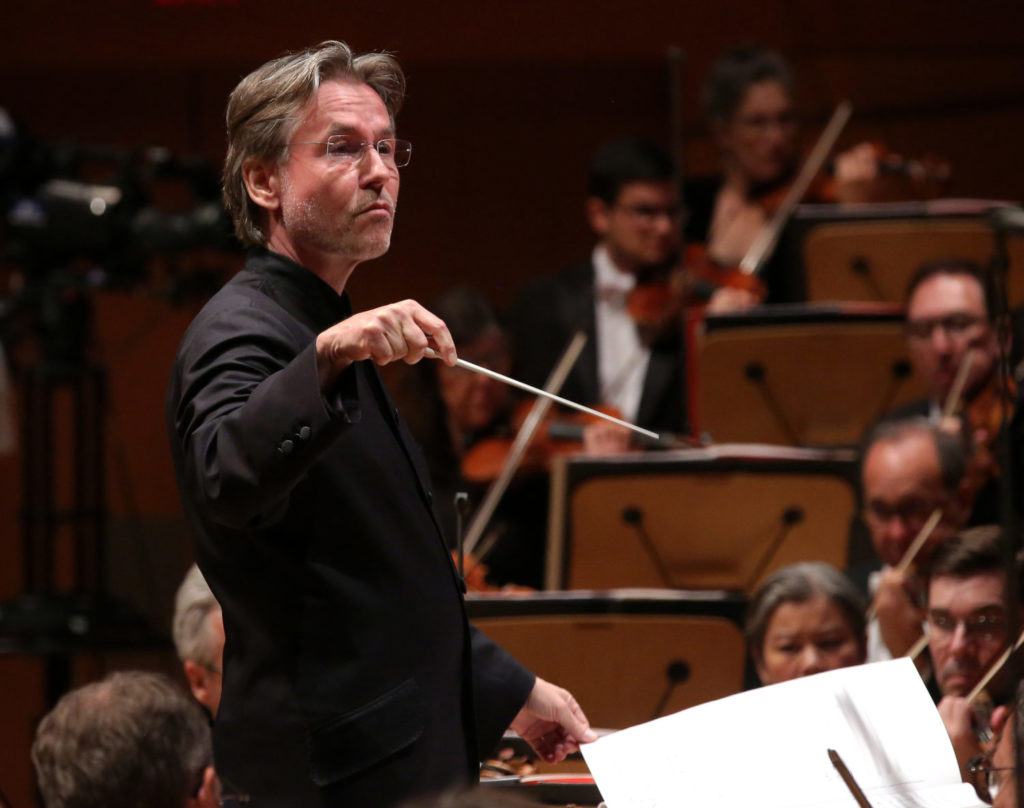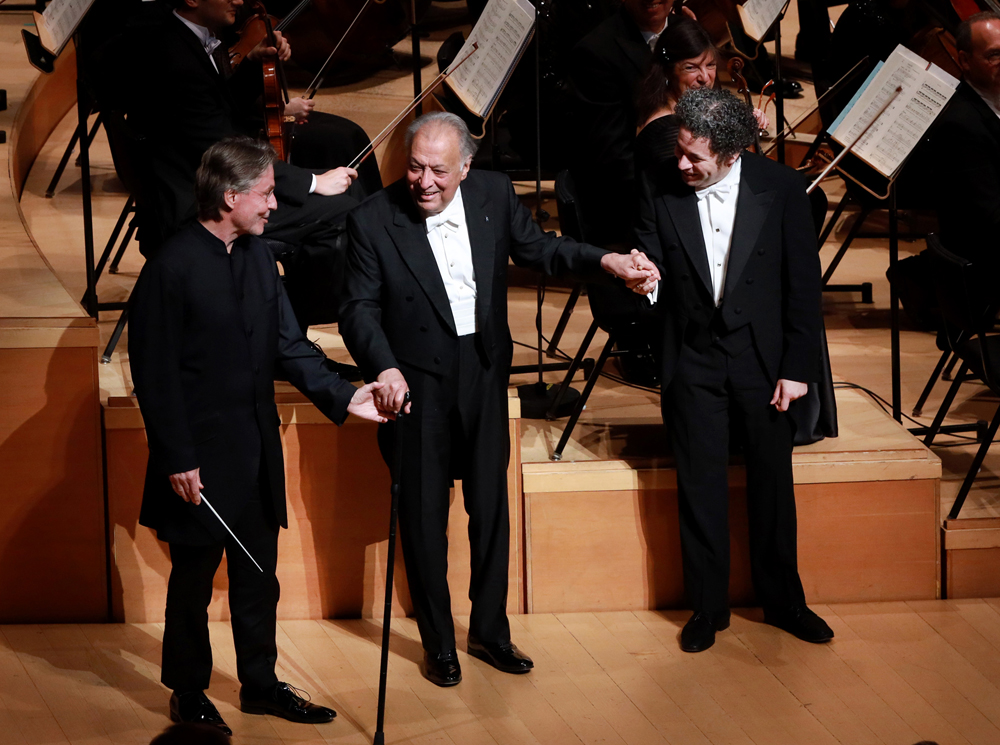L.A. Philharmonic’s past, present and future converged at the orchestra’s centennial birthday celebration concert and gala at Disney Hall on Thursday night, October 24, in a performance that included the unusual spectacle of three of its legendary conductors simultaneously conducting the world premiere of a new work.
The gala was the final event of L.A. Phil’s 2018-2019 centennial season and occurred on the same day as the orchestra’s debut performance at Trinity Auditorium — an elegant, now-vacant edifice located at the corner of Ninth Street and Grand Avenue down the hill from Disney Hall — exactly 100 years ago, on October 24, 1919. English conductor Walter Henry Rothwell led L.A. Philharmonic through its debut performance at Trinity Auditorium — with a program that included works by Dvorák, Weber, Liszt, and Chabrier — but it took three celebrity conductors to guide the orchestra through a different program last night at Disney Hall.
The twist at the centennial concert was that three longtime L.A. Phil conductors — conductor emeritus Zubin Mehta, conductor laureate Esa-Pekka Salonen and current L.A. Phil conductor/music and artistic director Gustavo Dudamel — took turns leading the band before all three assembled for the grand finale, the world premiere of Icelandic composer Daníel Bjarnason’s instrumental piece From Space I Saw Earth. A large version of the orchestra — including piano, two harps and a full complement of percussionists — was assembled for the first work of the night, Polish composer Witold Lutoslawski’s Symphony No. 4, which was originally scheduled to be performed third on the program but was moved up earlier following an onstage announcement.
The orchestra was dressed even more formally than usual for the occasion, with the women musicians wearing long black dresses or pants and the men outfitted in black suits with white shirts and white bow ties. Most of the near-capacity audience was also decked out in suits and dramatic floor-length gowns. Eschewing the de rigueur white shirt and white bow tie that Mehta and Dudamel were sporting, Salonen was dressed simply in all black as he calmly instigated the slow murmur of cellos and clarinets that unfolds at the beginning of Lutoslawski’s symphony.

Esa-Pekka Salonen (Mathew Imaging)
Before long, harpists Lou Anne Neill and Maria Casale began weaving their hands in circular motions as if they were sitting at looms, conjuring a witchy web of blurry sounds spiked with febrile melodies artfully unwound by clarinetist Burt Hara. The foreboding pull of strings built momentum before jolts of brass shook things up and then subsided again. The symphony alternated between the madcap interplay of flutes and percussion and simmering, bubbling volcanic moments that swelled and lurched forward with increasing grandeur. A brief, intimate interlude of violins gave way to a rousing, brassy finale that Salonen administered with intuitive grace.
Mehta was the next conductor of the night, greeted by a long standing ovation. Sitting in a chair at the conductor’s podium, Mehta, who was L.A. Phil’s music director from 1962 to 1978, began with Richard Wagner’s Prelude to Die Meistersinger von Nürnberg. The romantic, populist pomp of the buoyant 10-minute piece felt anticlimactic following the enchanting mysteries of Lutoslawski’s icy, shifting soundscapes, but both conductor and orchestra delivered Wagner’s syrupy melodies with vibrancy and force. Mehta followed the prelude with another traditional work, French composer Maurice Ravel’s waltz La valse, which swirled with pretty melodies before culminating with brassy aplomb.
The mood shifted again when Dudamel came out to conduct Igor Stravinsky’s suite from the 1919 version of The Firebird, a classic piece that still retains much of its startling boldness. The low rumble of cellos felt quietly portentous, and Dudamel crouched down at his pulpit to restrain the orchestra and maintain a careful, quiet volume during the softer moments so that when the horns eventually erupted, the dynamic contrast was even more intense than usual. Oboist Marion Kuszyk and clarinetist Boris Allakhverdyan were especially nuanced on The Firebird. Alternately raising his hands high above his head and pulling sounds from the orchestra with digging motions, Dudamel wrested more volume for the thrilling close of the suite.
Next, stagehands played musical chairs and realigned the stage during an extended break that was almost as long as the final work of the evening, Bjarnason’s 12-minute From Space I Saw Earth. During such breaks, self-congratulatory film clips with cloying, Hallmark-style narration were screened, profiling the three conductors and L.A. Phil’s history. The musical performances didn’t really need explanation, but the long break was necessary to realign the stage so that the three conductors could interact with different parts of the orchestra.

Esa-Pekka Salonen, Zubin Mehta and Gustavo Dudamel (Mathew Imaging)
Both Salonen and Mehta were installed at separate podiums situated about halfway back into the orchestra, while Dudamel stood at another podium at the front of the stage. The string section was seated up front and surrounded Dudamel, while the winds, horns and percussionists were positioned at the back of the stage. Percussionist Matthew Howard was stationed amid the thicket of pipes sprouting from Disney Hall’s in-house organ behind the stage. The orchestra also included Joanne Pearce Martin on piano and Neill on harp.
Pearce Martin instigated Bjarnason’s piece with spare flickers of piano as percussion slowly welled up. The composition was marked by gentle waves of sound that slowly moved across the stage, infused with a sheen of horns and wind instruments. The slow procession of sound eventually changed, with a darkening of horns and Joseph Pereira’s ever-masterful rolls on timpani evoking distant thunder. The wind instruments turned slightly eerie as the long waves of strings wrapped around the room.
One couldn’t help comparing the disparate styles of Dudamel, Salonen and Mehta as the three famous conductors attended to different parts of the orchestra. With minimal gestures, Mehta guided the horns and winds in a low-key manner. Dudamel was more demonstrative as he exhorted the string section, whereas Salonen was more expressive with his artful and fluid hands. Both Salonen and Mehta tended to defer to Dudamel, looking back across the stage to react to Dudamel’s tempo cues. All three conductors were relatively laidback as they allowed Bjarnason’s music to breathe and expand boundlessly.
The most charming passages came near the end, when members of Youth Orchestra Los Angeles (YOLA) in matching black T-shirts marched solemnly down the aisles, striking bells. The bells sounded like breezily febrile wind chimes, anointing Bjarnason’s work with a poignant loveliness as From Space I Saw Earth wound down into silence — a sublime spell that was momentarily broken when someone onstage accidentally clicked a bow, stick or baton. As Salonen smiled at the gaff, confetti and small paper images of each conductor floated down from the ceiling of Disney Hall, bringing an end to the 100-year party.
This weekend, each conductor takes over the hall for a day. On Friday, October 25, Mehta conducts Gustav Mahler’s Symphony No. 2, augmented by L.A. Master Chorale and vocalists Kristin Lewis and Mihoko Fujimura. On Saturday, October 26, Salonen conducts two works by Jean Sibelius as well as the world premiere of his own composition Gemini. The starry weekend concludes on Sunday afternoon, October 27, as Dudamel serves up the world premiere of Gabriela Ortiz’s Yanga, followed by the euphoric and transcendent joy of Ludwig van Beethoven’s Ninth Symphony.
Advertising disclosure: We may receive compensation for some of the links in our stories. Thank you for supporting LA Weekly and our advertisers.

